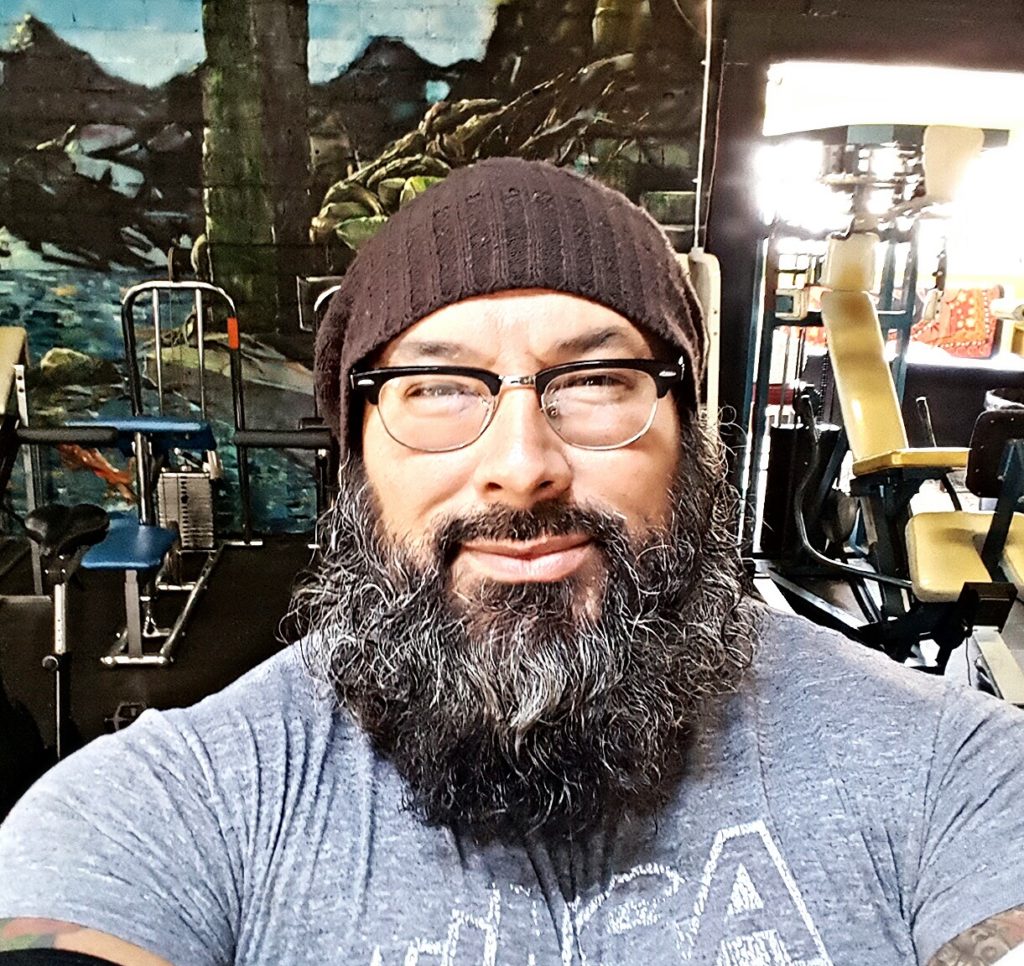1. Background
Brad Post, Create the Movement, host: We’re sitting with Johnny Price. How are you Johnny?
Johnny Price, The Philosophy Tree, guest: Good, buddy.
BP: We’re going to be talking about The Philosophy Tree. The first question is: could you tell us your story?
JP: As a kid I was always an athlete. I competed in just about every sport you could think of as a kid. I was a baseball player. I played football. I ran track. I raced BMX. I raced motorcycles. If there was a sport out there I did it. Probably the only thing I really didn’t play a whole lot of as a kid was basketball. As I got a little bit older I did; not as competitive because I hadn’t played it as long.
Other than that, all sports. If I was around it – I played something. I was a total statistician as a kid. I don’t care if I was 8, 10, 11 years old. If there was a sport and I watched it, I knew who the best players were. What their stats were. Whether it was tennis, or golf, or baseball, or whatever. I was just that kid. Always been pretty much consumed with athletics and the idea of that.
It was probably about 11 or 12-years-old that I saw my first bodybuilding magazine at a convenience store. You have several different versions that are out there now. But even 20 years ago you had a larger version. You had a lot of magazines that are no longer in publication that were in publication back then. Every month I couldn’t wait for the new ones to come out. To see what meets had taken place. And who had won. And what new workouts were in there.
So, even before I ever started working out I, was very consumed with the idea of working out with weights and bodybuilding at that time. I really hadn’t gotten into powerlifting yet, or even knew of powerlifting. All I knew was bodybuilding at that time. I followed everyone for years.
And then, when I think I was about 14 years-old I got my first concrete, the old plastic concrete, set of weights.
BP: Oh yeah, I remember those.
JP: And so I had a friend, a girl in my 9th grade class, who had bought me a set for my birthday. And that was my first set that I ever had.
BP: Were you kind of a skinny, scrawny kid?
JP: I was skinny as bones. Skinny and fast. And so, I worked out all the time at home. Of course, I was playing football. So in off-season football, once I got into my sophomore year we worked out, in the off-season as well.
Once I got in my 10th grade-year we had access to steel weights and things like that. So I put the old stuff aside. But I still worked out at home quite a bit when I could. One day I just happened to run across a guy who was doing assisted strength training; coaching at our high school. A guy named Ricky Crain who was a five-time world powerlifting champion, ten-time national champion. That was the first time I really recognized what powerlifting was. It pretty much changed the game for me. I was no longer interested in bodybuilding. I wanted to be a strength athlete.
So, as I got older, I continued to work out with weights. I played football. I started training with Ricky. And he invited me to come over to his gym and train with some of the guys that he trained with. And just kind of learn his system.
And the thing about powerlifting that I liked was that’s it’s very scientific. There’s an approach to that so you maximize your efficiency levels. There’s a periodization system, a cycling system, where your workouts are based on a certain percentage. So every week it’s 70%, 75%, 80% as you work your way up over maybe a three-month training cycle. Until you max out, then you drop back down, and then you work your way back up.
So it’s always a revolving, stepping pattern up and down. Each cycling period you’re hoping to exceed your previous lifts by 5, 10, 15, 20 pounds. So, it’s really at that time I got consumed with that. And learning that system. Part of the system I learned from him I still use to this day. As far as the periodization methods, and the cycling system. Now, I changed it over the years. I think it’s a little bit better, as far as the volume we create compared to back then. We didn’t create a lot of volume. What I mean is we didn’t integrate a lot of high-rep training into our strength system. We integrate a lot of high-rep training on the lighter end. So we’re working more volume and endurance as we’re building the strength level. So, that’s one of the main things that we’ve changed over the years.
And so, as I got older and started competing, it’s one of those things that I just love doing. I love competing. I love seeing how far I can take my body and push it to certain limits. Competing in bench-press meets, or competing in three-lift meets. Which is the squat, the bench press and the dead lift. I did that for years. I haven’t competed in a few years, as of late. But I still train to this day. Just like I would if I was going to a meet. I get all my lifts – my back squat, my dead lifts, my bench press. I accessorize and make sure I get all my assistance movements as well.
Even though I’m not competing as much, I still train as if I was going to a meet. So, if one popped up. I’m always going to be in pretty good condition.
You would always like to have a three-month training cycle. A good twelve-week period in which you can train. A lot of times one of the problems that you get with a lot of gyms around here, and even maybe some in Texas and Arkansas, that will send out fliers to Oklahoma, is that they don’t give you enough time to train. You get a flyer in the mail two weeks before a meet, and you really haven’t had time to train properly. But when you’re training for a meet you really want a good three-month training cycle. So that way you can start at the very bottom, work your way up, and peak at the right time. It’s no different than if you were going to train for the Olympics, or the Nationals, or anything like that – it’s all about peaking at the right time so you can maximize your results.
BP: So, after high school, did you go into college? Played
JP: Played football for a couple of years. Had a slight knee injury that kind of put me back for about a year. You know, you have a small window when you’re playing sports. You always have new people coming up. And it’s just easy to get out of the system. Growing up I loved football probably more than any sport that I ever played besides powerlifting. I loved the idea of being out on the field and playing.
But I was okay with walking away from it after playing for a couple of years, and really devoting myself to powerlifting. I really wanted to see what I was capable of and what my physical limits were. So that’s one thing that I really, really pushed for at that time. I was still working for Ricky at that time. And I used to deliver up to Oklahoma State University, the University of Oklahoma, I would deliver them all of their protein drinks, all of their supplement drinks on weekends. Then I would hit all the big powerlifting gyms, and Gold’s Gym, and all those places in Oklahoma City on my weekend route.
And then Ricky, at that time, he was still competing and he was still wining national championships, and competing at world’s. He and I would do, or I would actually go with him, when he would do little Strength seminars. He was a devout Christian Fellow. And so we would go these little local churches in different towns. And we would set up equipment. And he would preach a little bit, and do some lifting and things like that. So, I was one of the few guys that trained with him that did some of that other stuff with him. A lot of the guys didn’t like to do it, but I was always pretty cool with going and helping him out. I was like a sponge back then. I wanted to learn as much as I could. He was a well-respected champion.
- Train. But Train Efficiently.
About five years ago, Powerlifting USA, which at one time, was probably one of the only major powerlifting magazines in the entire world. Ranked him the No. 1 165-pound powerlifter of all time. So, it was really cool just to train under him and learn how to train right.
And there’s a big thing that we implement to this day. And what we do is how you train. If we come into the gym all the time and we’re training, yet we’re not training efficiently, then we’re really hindering our results. So we really want to make sure we have people on the right track. So as their efficiency level goes up their body mechanics work with the weights better, versus fighting against that. You’re going to optimize your ability to gain results, and less injuries, and all those things that kind of go hand-in-hand.
So, I really learned a lot from him as far as being technical with our movements. Pushing your knees up when you squat; keep a nice vertical position; push your chest out. When you’re deadlifting push your feet to the floor; keep your head up. You’re working on balance. You want the bar as close to the body as you can so the bar is in line with the body. If you let the bar get too far away your hips come and then you’re more susceptible to injury. Just small things like that that a lot of people don’t think of. But the technical aspect of that, once you get that down, it’s a game changer for you to be able to see what you’re capable of doing in the long run.
BP: When did you decide to start doing training on your own?
JP: When I was in college was when I got my first training job. And I worked at a place called Kegels USA Fitness which was in Midwest City, Oklahoma. And I spent a semester there making up some grades at a place called Rose State College. And I lived there with some buddies. And they were playing for the baseball team there. And I just needed a job, so I went and applied and they hired me. So I spent probably a year working there. And even when I was living in Edmond I was still driving to Midwest City. And then they had another location around NW 51st that I ended up going to. So, I worked for Kegels for a while off and on. I worked for All-American Fitness. They had a location in Oklahoma City, off Northwest Expressway, so I worked there as well.
I was training even in school, and I liked it. I obviously didn’t know what I knew then, but I knew I had a desire and I was willing to learn. And I thought I was a pretty good trainer back then. I never wanted to be a ‘clipboard-trainer.’ One of those guys with the clipboard and I’m just writing numbers down. I really wanted to teach people. And I think, maybe, sometimes you use the word ‘trainer’, but I think you’re really more of a coach. You’re coaching people how to do things properly. It’s not just a matter of, “Okay, Brad. Sit down and give 10 reps here. And 10 reps over here.” And I’m writing your numbers down, or whatever. I’m more of a coach really. I’m coaching you how to lift efficiently. How to exercise at a higher level and all those things. It’s kind of a combination of both, I’d guess you’d say.
- What Makes The Philosophy Tree Different?
BP: Well, tell us a little bit about The Philosophy Tree. What makes the Philosophy Tree different?
JP: When I opened up my first gym, 10 years ago, or so.
BP: Here in Tulsa?
JP: Here in Tulsa. We were in midtown for six or seven years before we moved to downtown. And we were down there for a little over two years before we moved to our current location. So, it’s been around 10 years all together. At that time, we were called ‘Johnny Price Health and Strength Training Systems.’ And it was good little setup. We were in a great location. But you know, when you’re looking at the system that you buy into, basically what I did is I bought a gym that I was already training at. The guy was going to retire. So, it’s one of those things where I had too many clients to go somewhere else and train. So, you really have an option at that point to do something else, or buy a place and really nurture your craft. And so, that’s what I chose to do at that time.
- Minimizing Injury
As far as what we wanted for our vision was Cross Fit was really coming along over last six or seven years. Everybody was jumping on the Cross Fit bandwagon. And even though I love a lot of the concepts of that that there’s a lot of things that I think offer a better reward, or just as good with less risk factor. So, what we wanted to do was still train people at the highest level, but be very particular about the exercise that we use. So that we’re still training you as efficient as you’re going get anywhere. But there’s also less risk. And if there’s less than risk you’re not as susceptible to injury and then we’re keeping you going better. And so, we really picked and choose what exercises we wanted to use, and which ones we thought weren’t as important.
I think it’s really cool if you can go over there and flip upside-down and do handstand pushups. You’re really working the delts and that’s great. But there’s also a lot of injury, or susceptibility injury, as far as your risks and things like that from being in that position when there are other exercises that can give you the same reward without the risk. So that’s just kind of an example of where we were really picking and choosing what exercises that we wanted to do, and which ones we wanted to hold off. We definitely want to train our compound movements.
Whether or not you use a powerlifting term, or a strength training term, or Olympic-lifting term, I think people sometimes get afraid when you start mentioning those things. But basically they’re very simple movements when they’re done correctly. Really there’s not a lot of susceptibility to injury unless you’re just lifting way too heavy and your form is off.
So, again, we’re coaching and teaching people how to do things properly. There’s the benefit from that. The thing about a compound movement is you’re working many muscle groups together at one time. Whether you’re squatting, or deadlifting, you’re doing power cleans, or you’re bench pressing, or push pressing, or any of those major movements, really overall they build the best strength foundation.
And even a person that’s not interested in powerlifting or bodybuilding, still needs a basic foundation of strength. Statistics show that people who are stronger live longer. It helps with your bone density. People who are arthritic, or have other issues like that, they do really well when they resist and strain.
- The Importance of Both Strength and Conditioning
So, there’s a lot of benefits from that. In some ways, that’s probably the core of our foundation. And the basis is the strength training. But one thing that we don’t sacrifice is we won’t sacrifice your conditioning for strength. We want to make sure that your condition is good also. So, our desire is never to build strong people who are unhealthy, or that don’t have conditioning. Conditioning is always first with us. We back that up extensively with our strength training so that you a combination of both.
If you look at what the best athletes in the world do, whether or not you’re a soccer player, you’re a baseball player, you’re a football player, whatever. Strength and conditioning is the basis of what they do. They build everything around that. So, basically we do something very similar. We want to give you the best foundation on which you can build anything. So, if you want to go out and go play Frisbee golf all day long, or you want to go play tennis, or you want to go run around, you have the strength and the conditioning to allow you to do all those things because you’ve been trained at a nice level.
BP: So, one thing I wanted to talk about, just give it a different way of training. A new client comes to see you.
- A Higher Physical Level
JR: The one thing that we always wanted to a lit bit differently, and this is getting back to being just a standard clipboard-trainer, or teaching our clients how exist at a higher level physically. And so, one thing that we try to do with coaching and teaching is give them the tools that they need whether they train with us or not. To go out and maintain all those things even on their own down the road. Some people need that accountability. They actually want it. And there’s some people that want to learn. They want to be able to go out and to their own thing. Or, they may relocate and they may not have the ability to train. So what we teach them are things that they can take with them.
So, it’s always been real important for us to be able to do that. I think another thing that a lot of people sometimes overlook, as far as training and where you’re at, is the facility in which you train in. I think it’s very important that it has a very good vibe to it. I don’t necessarily agree, or like, what Cross Fitters do when the call their gyms ‘boxes.’ To me, it just kind of generalizes what you’re doing. “Oh yeah. We’re going to go train in our box today.” For us it’s a lot more than just a box. And I’m not saying they mean that in a degrading way. It’s a term that they use.
But really for us it’s something a whole lot more than that because we spend so much time there. And our clients spend so much time there. Really it’s like a second home, and everybody that you know over time, or you see every morning, or every afternoon. Over a while, it almost becomes like a family. And you get people rooting you on. Or, I have people that come in and go, “Man, I’ve been watching that person over there for six months, and they’ve really come a long way.” I’ve had people that end up networking and doing business together, and things like that. So there’s actually a lot of things that can evolve from being in the right atmosphere. So, for us, in a way it’s always been kind of a Zen haven for us.
We wanted people to come in and feel very comfortable in that environment. And kind of feel like it’s a place of peace. I know it may seem like a contradictory when you’re talking about going in and getting your butt kicked really hard, and finding some peace in that. But I think sometimes if you can walk into an environment that you just kind of feel at home it makes it easier to have the other end happen as well.
We want people to walk in. We want them to enjoy where they’re at and to enjoy the facility. Ours, unlike a lot other places, has a very urban feel with the concrete floors and the brick floors. Our building is 108 years old. It’s not like it’s a brand new shiny building. But we kind of like that urban, raw feel to it.
We haven’t been able to transition quite as much yet, compared to our last facility. As far as getting some of the art and the murals going like we wanted to. Some of that stuff we’ve had to put on hold. But in the next six, eight months or so, we hope to get back on board in continuing to foster and create that environment which we feel is important.
- Personal Inspiration From Helping Others
BP: What inspires you?
JP: I think helping people more than anything. And I know it’s a clichéd term that most trainers use. “I just want to help people.” But I think if you can help change someone’s life. The quality of their life. They longevity of their life. That’s a really cool thing to be able to do. There’s so many people that are so caught up in living and working every day at such a fast pace that we really lose sight of how important our life is.
If we can just step back for just a moment, and think about life and what that entails. And what a gift that is. Our quality, and the desire to have that longevity, should be at the forefront of everything that we do. It’s the life that we’ve been blessed with. So, I think sometimes we’re so busy with the hustle and bustle that we actually just lose sight. I’m alive. I’m a living person. I’m living, and breathing, and thinking, and I’m being creative, and I’m bringing children into this world. What an amazing thing and gift that is.
I think we’ve become a very unhealthy nation. At one end, we may have some of the best athletes in the world. But we’re also the most obese nation. The state that we live in is one of the most obese. So if we can help people reprogram their brain to how important exercise and nutrition can be to extending their life. That is a really cool thing and we get to do it in our own environment. And they way that we do it and foster relationships. I think that’s really what separates us a little bit because we’re very passionate about that.
- The Importance of Commitment and Consistency
BP: Who would you say is your ideal client?
JP: Someone who’s committed. I think that with anything your commitment level sets the tone. If I’m not committed at my job, I’m probably not going to keep it very long. Eventually, someone’s going to terminate me. They’re going to bring someone else who’s more committed, has a better desire, and a wiliness to learn. Things like that. If my relationship, if I’m not committed to that, I’m probably not going to be in it very long.
Your commitment to anything will determine a lot as far as the outcome goes. So we really have to be committed in all facets of our life to reap those rewards that we hope to get. If we hope to find the love of our life, we have to do the right things. And it may be living a certain way. Having certain values. Getting a certain education. All these things in the end may lead you to the person you always hoped to be with. And then have the family that you want. Your education, how you study in school may set the tone of you getting the job that you’ve always wanted.
I think all those things have a chain reaction on how you’re able to affect people and change people lives for the better. And so with that commitment level, I think that it’s nice to be able to see someone change.
We have a client who’s been with us now for about six or seven months. She’s lost almost 60 pounds. So being able to watch her change and progress over six months and lose 60 pounds. She’s basically lost a little person. She went from wearing a size 28 down to a size 16, or something, right now. And she still wants to lose another 30 or 40 more pounds. And she’s pretty tall, probably not quite as tall as Stacey, but she’s pretty tall, so she carries it pretty well.
But again, being able to see what consistency can do – that also inspires other people. Because they’re like, “Wow. If I was that consistent look where I would be now.” The past month, or two, or three, or five months you may have clients that aren’t making it three days a week. They’re only making it once a week. Or, they make it twice one week and miss a week. So they’re never really fulfilling those things that they want because their consistency level is off. If they can look at someone that is consistent and see that, it might inspire them to pick their game up a little bit.
- Transforming the Body and Mind
BP: What can people, or what can your ideal client expect by going through training with you?
JP: I think, hopefully, results. I think that you’re paying for a service. We’ve always tried to not have that drill-sergeant approach. There are certain clients that like being pushed hard. But a lot of times it’s about us setting things in motion and watching you play that out. I’m watching you from 30 feet away, or 20 feet away, from across the gym as I’m over here with this person, or over there with that person. Kind of moving around from person to person. Just making sure that you are moving all the time.
That’s want we want to do. We want to make sure that you’re keep your heart rate up so it’s at an aerobic level. We want to make sure that you’re moving constantly and that you’re not stagnant. There’s going to be occasions when there might be a transition period, or you might be down a minute or two, but overall the idea is to keep you moving the whole time. If you’re moving the whole time you’re burning more calories. You’re keep your heart rate up, your aerobic heart rate up.
In conjunction with resistance training where we’re building bone density. We’re creating a better person in a physical sense. If we can help people do that, it also helps people sometimes who may not have the confidence to go out into the world because they’re a little bit more apprehensive. So, if we can help change them physically, too, it might give them the confidence they need to go out and apply for that job they wouldn’t apply for. Or, step out into the world and live a little bit more when they wouldn’t. So, again, there’s a lot of ramifications on a positive note that can happen just by making small changes in your life.
Become a Client
Train like an athlete
Change picture to more kind image
Looking for the next evolutionary change in your training
[1:29]
“First session is free”
[1:31]
Facebook & IG
[1:31]
Phone # and email
[1:32]
Johnny Price – Formerly of xyz tv show
dominick [1:37 PM]
“…and POWER in motion”
As seen on Fox 23
http://www.fox23.com/video?videoId=89411126&videoVersion=1.0
https://www.reddit.com/r/tulsa/comments/3lr6jh/powerolympic_lifting_gyms_in_tulsa/











